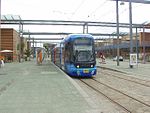Weikerlsee
Austria geography stubsLakes of Upper Austria

Weikerlsee is a pair of recreational lakes just south of the confluence of the Traun and the Danube in the urban district of Ebelsberg. It includes the bathing lake, a green belt, some parking spaces, toilets, a snack bar and a nudist area on the north bank of the smaller of the two lakes. A canal joins the smaller and the larger lakes. To the south of the Larger Weiklsee are the rainwater drainage basins for the Linz sewage network.
Excerpt from the Wikipedia article Weikerlsee (License: CC BY-SA 3.0, Authors, Images).Weikerlsee
Linz Solar-City
Geographical coordinates (GPS) Address Nearby Places Show on map
Geographical coordinates (GPS)
| Latitude | Longitude |
|---|---|
| N 48.264444444444 ° | E 14.370833333333 ° |
Address
4030 Linz, Solar-City
Upper Austria, Austria
Open on Google Maps









